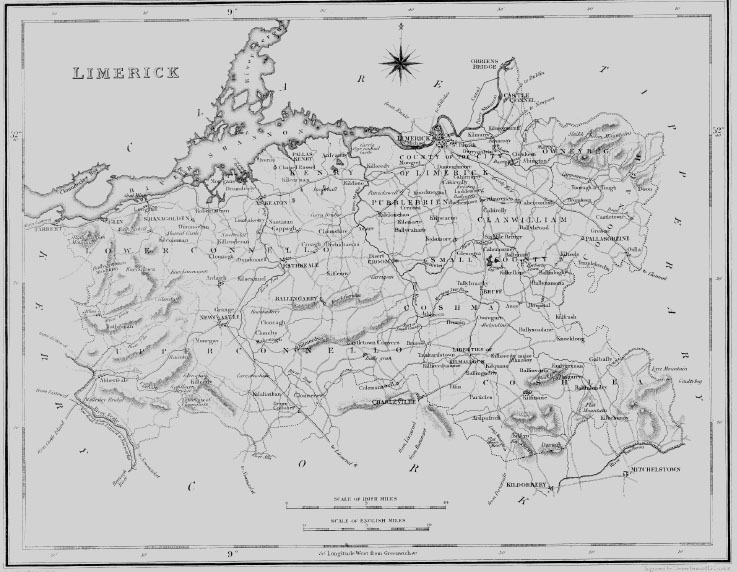| Accompanying Lewis map for Limerick 
|
| GRANGE |
| GRANGE, or GRANSHAW, a parish, in the Glenquin Division of the barony of UPPER CONNELLO, county of LIMERICK, and province of MUNSTER, 2 miles (N. E.) from Newcastle, on the road to Ballingarry ; containing 721 inhabitants. This parish comprises 2828 statute acres, as applotted under the tithe act. The land is very good, and much of it is under an excellent system of tillage ; the remainder is rich meadow and pasture, principally in large dairy farms. The river Deel, over which there is a curious old bridge, passes through the parish, the entire of which was formerly the property of the Courtenay family, but the greater part was sold during the life of the late Earl of Devon. The seats are Knockaderry, the residence of J. D. Evans, Esq. ; Chesterfield, of Major Sullivan ; and Dromin House, of Nicholas Meade, Esq. It is a rectory, in the gift of the Earl of Devon: the tithes amount to £180, and there is a glebe of five acres. In the R. C. divisions it forms part of the union or district of Knockaderry. The ruins of the old church are beautifully situated on the river Deel. |
| GRANGE |
| GRANGE, or MANISTER GRANGE, a parish, or district, in the barony of SMALL COUNTY, county of LIMERICK, and province of MUNSTER, 3 miles (N.) from Bruff, on the road to Limerick: the population is included in the return for Manister. It comprises 1224 statute acres, as applotted under the tithe act, and consists of very good land, which is generally based on limestone, and chiefly in large dairy farms. From an inquisition taken in the reign of Elizabeth, this district appears to have belonged to the parish of Manister, of which it still forms a part for civil purposes. The village of Six-mile-bridge is within its limits. It is a rectory, in the diocese of Limerick, entirely impropriate in Lord Southwell: the tithes amount to £83. 6. 2. In the R. C. divisions it forms part of the union or district of Bruff. Here are three druidical circles, the largest of which is 44- yards in diameter, and consists of 65 upright stones ; they are principally of limestone, sandstone, and clay-slate, but the largest, which is thirteen feet high, seven broad, and four thick, is formed of breccia. The second circle is 49 yards in diameter and consists of 72 smaller stones . and the third, which consists of 15 large shape-less blocks, is 17 yards in diameter. On the summit of Knockfinnell, which overhangs Lough Gur, are two extensive earthen forts. |
|